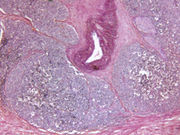More high-grade cancers detected with MRF-TB vs. systematic biopsy in men undergoing primary biopsy
TUESDAY, Nov. 17, 2015 (HealthDay News) — Magnetic resonance imaging-ultrasound fusion targeted prostate biopsy (MRF-TB) improves detection and risk stratification of high-grade disease and limits detection of clinically insignificant prostate cancer, according to a study published in the December issue of the The Journal of Urology.
Neil Mendhiratta, from the New York University Langone Medical Center in New York City, and colleagues reported clinical outcomes for 452 consecutive men presenting for primary prostate biopsy. Participants underwent prebiopsy multiparametric magnetic resonance imaging followed by MRF-TB and systematic biopsy.
The researchers detected prostate cancer in 54.2 percent of 382 men (mean age, 64 years; mean prostate-specific antigen, 6.8 ng/mL) who met inclusion criteria. The cancer detection rate was 49.2 percent for systematic biopsy and 43.5 percent for MRF-TB (P = 0.006). Compared with systematic biopsy, MRF-TB detected more Gleason score 7 or greater cancers (88.6 versus 77.3 percent; P = 0.037). Overall, 82.9 percent of the 41 cancers detected by systematic biopsy but not by MRF-TB demonstrated Gleason 6 disease, and 63.4 and 82.9 percent, respectively, were clinically insignificant by Epstein criteria and a University of California-San Francisco-Cancer of the Prostate Risk Assessment score of 2 or less.
“Prebiopsy magnetic resonance imaging followed by MRF-TB decreases the detection of low-risk cancers while significantly improving the detection and risk stratification of high-grade disease,” the authors write.
Copyright © 2015 HealthDay. All rights reserved.








